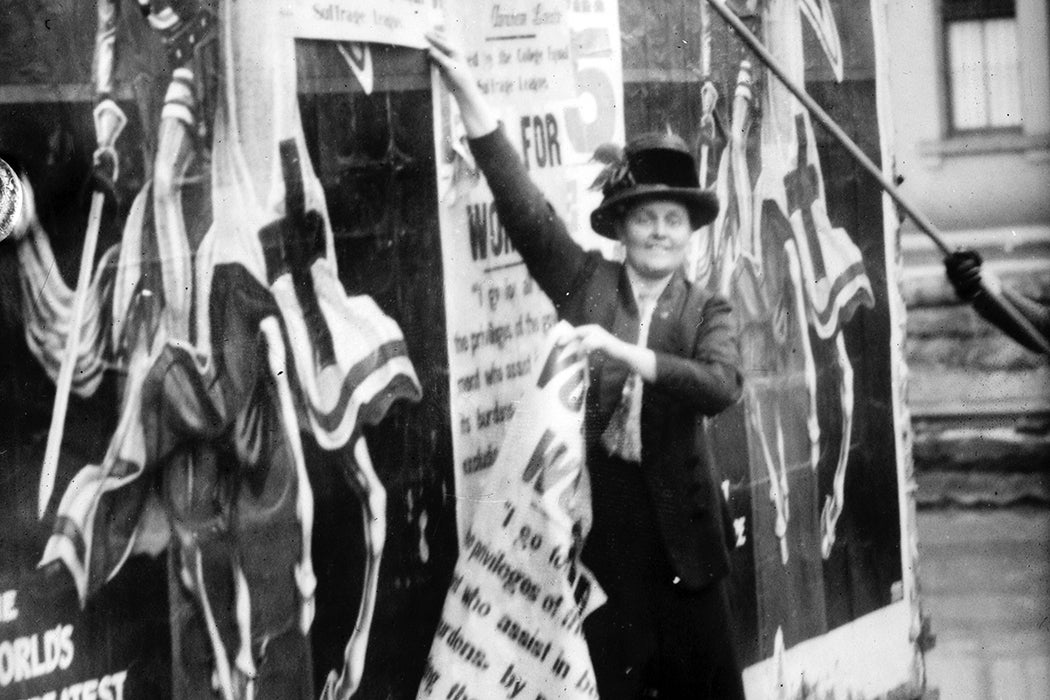In surveying how American media has portrayed women in the modern era, it may be instructive to recall that one of the earliest American films ever made features a suffragette. The Lady Barber (1898) takes over a barber shop and starts “snipping the hair of bewildered men.” For the next two decades, those fighting for women’s suffrage were generally portrayed as emasculating figures of mockery or horror in the movies.
According to these anti-suffrage movies, the suffragette was unwomanly, de-sexed (or sex-crazed), and undermined the home and the nation by turning sex roles upside-down. “The films depicted women terrorizing men from coast to coast, from frontier towns to the streets of New York,” writes Kay Sloan. Sometimes the portrayals were quite literally masculine: Charlie Chaplin wore drag to play the suffragette in A Busy Day of 1914. At the end of the movie, she’s pushed off a pier and drowned by her humiliated male companion. This was, it should be reiterated, a comedy.
“The final bubbles rising from the water’s surface seemed to promise the last gasps of the votes-for-women movement,” writes Sloan, who details this pernicious imagery, the age of anxiety that produced it, and how the suffragists resorted to their own movies to counter it. She also quotes a New York Times editorial of 1914 warning against the “reign of terror” of “fiendish” women like Harriet Stanton Blatch of the Women’s Political Union, one of the groups that got New York women the right to vote in 1917.
For their part, suffragists realized early on the power of the newsreel, pioneered in the U.S. in 1911 by Pathé. Filmed marches and demonstrations spread the word about women’s suffrage much better than suffragists “giving speeches to each other in public.” But newsreels were double-edged: the same footage of a huge 1912 suffrage parade in New York found its way into an anti-suffrage film and the movement’s own Votes for Women (1912).
Votes for Women was one of four avowedly pro-suffrage films produced by the movement working with commercial film companies who figured there were profits in both the anti- and pro-suffrage perspectives. Suffrage and the Man (1912) was a comedy about a man abandoning his fiancée because she’s a suffragist (spoiler; he comes back). Another melodrama with attractive suffragists leading the fight against corrupt male political bosses, 1913’s 80 Million Women Want—? guest-starred Blatch and the even more famous, and much arrested, Emmeline Pankhurst. Your Girl and Mine of 1914 aimed to be the Uncle Tom’s Cabin of suffrage films, but didn’t quite succeed, doing less business than the earlier movies.
Sloan notes, “Though the movement bowed to expectations of movie audiences with attractive heroines, racist implications, and fairy-tale romance, an angry undercurrent rumbled beneath its cinematic gestures of conciliation.”
Weekly Newsletter
This was, after all, an enormous battle over both the humanity and citizenship of half the population. Meanwhile, more militant British suffragists blazed the trail in exploiting the camera, and being exploited by it. A Gaumont cameraman recording the British Derby of 1913 unintentionally captured Emily W. Davison throwing herself under the King’s own horse during the race in a suicidal protest against women’s inequality. Gaumont then intentionally filmed her solemn funeral. But “only the dramatic moments of suffragism merited newsreel coverage,” notes Sloan. “Whether the newsreels’ image of suffragists was derogatory or sympathetic, suffrage became an immediate issue when it was projected on movie screens. The films might ridicule the suffrage movement, but its power could not be denied or ignored.”
Women won the vote in five U.S. states between 1910 and 1914. The 19th Amendment to the Constitution giving women the right to vote was ratified in 1920, but movies would continue to express the “insecurities of a nation” over sexual politics for some time.







